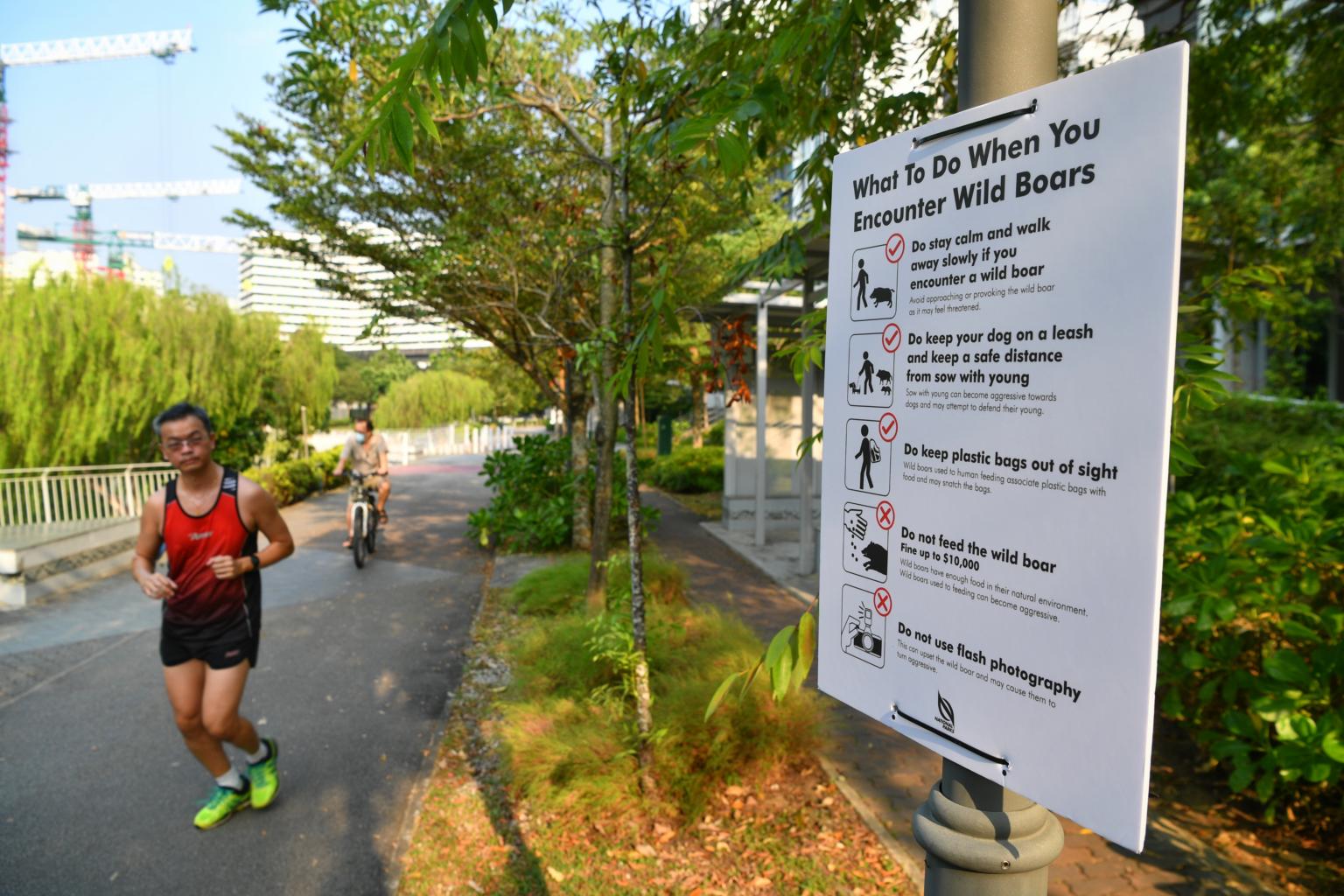Feeding wildlife a major reason for spike in wild animal numbers: NParks
Sign up now: Get ST's newsletters delivered to your inbox

A jogger runs past a wild boar advisory at Punggol Waterway on Feb 26, 2021.
ST PHOTO: CHONG JUN LIANG
Follow topic:
SINGAPORE - Feeding is a major reason for a spike in wild animal numbers, the National Parks Board (NParks) noted, and preventing their feeding by people is one of its key animal management strategies.
Wildlife-human encounters
With more development projects in the works, animals are coming into closer contact with humans than before, Animal Concerns Research and Education Society (Acres) co-chief executive Anbarasi Boopal said.
Acres handles about 1,200 injured and displaced animals a month, ranging from birds to mammals and reptiles in the built-up environment. Examples include a raptor which flew into a building, a python at a void deck and a civet in an attic space.
"These encounters are becoming more common because of our greening of the city, which attracts wildlife closer to built-up areas, and habitat fragmentation, which brings people closer to habitats due to developments, forcing animals to cross man-made barriers like roads or residential areas. These have brought humans and wildlife closer," Ms Anbarasi said.
Feeding and education
Food supply is critical in managing wildlife numbers. Feeding of wildlife by people increases their population to beyond the natural carrying capacity of a habitat and leads to overpopulation, said Dr Adrian Loo, group director of wildlife management at NParks.
When the animal population has reached the habitat's carrying capacity, which is the maximum number it can sustain, the population size plateaus. Animals naturally spend most of their energy and time foraging for food, giving them less time to mate.
However, when humans feed them, wild animals spend less time looking for food and have more time to mate, increasing the population beyond what the habitat can support, Dr Loo said.
"People think that they are doing a kind deed by feeding these animals but it instead leads to ill outcomes."
Places like Lorong Halus and Pasir Ris have become feeding hot spots, said Dr Loo, recounting incidents of people throwing buckets of bread to wild boars in Lorong Halus. Patrols have also been stepped up in order to catch feeders and more signs remind the public to not feed animals.

A still image from a video taken by a Shin Min reader showing a wild boar crossing a road in the Punggol Walk area on Feb 20, 2021.
PHOTO: SHIN MIN READER
NParks is also slowly removing oil palms - an invasive species in Singapore - from the forests in order to rein in the food supply of wild boars, Dr Loo added.
The kernels of oil palms store a lot of fats, providing a lot of energy to these boars. When the boars consume them, it leaves them satiated and reduces their need to forage for food, giving them additional time and energy to reproduce.
"In managing human-wildlife conflict, feeding is probably a very big tool - no feeding, be alert to your surroundings and observe these wild animals from a distance," Dr Loo said.
Shepherding animals
When a forested area is cleared for development, animals have to be shepherded to other areas in stages. Shepherding is carried out to guide wildlife to adjacent forested areas where possible.
NParks works with development agencies to ensure their consultants have a shepherding or relocation plan. A baseline study should be first conducted of what animals there are and how they can be managed, with recommendations of where they can be shepherded to, and how, considered next.
Dr Andie Ang, a research scientist with Mandai Nature, who conducts forest surveys, also suggested creating more green connections islandwide to allow animals to move between habitats without the need to venture into urban spaces.
But shepherding animals to limited areas available also has its drawbacks, as it can result in crowding in a habitat, prompting animals to leave to search for new habitats. They may end up becoming roadkill, or create a human-wildlife conflict, Ms Anbarasi said.
Other considerations, such as if the animal is able to adapt to its new environment will also have to be considered.
"We will have to shift the mindset away from the notion that relocation is a good solution for all cases," Ms Anbarasi said.
For smaller animals such as snakes, it can be feasible to some extent. However, with larger social mammals such as otters, macaques and wild boars - it is not as straightforward as the animals could go through an immense amount of stress in the process.
Culling
Culling of wild animals remains the last resort, Mr Loo stressed.
For instance in 2014, 80 wild boars in the Lower Peirce area were culled. This was to improve public safety and to reduce the animals' damage to the vegetation.
Ms Anbarasi welcomed that NParks continues to look at the science before management solutions such as culling are designed.
Ms Chriszanne Burger, 33, who runs a wildlife sanctuary called Felidae Centre in South Africa, supported NParks' actions, though she was disheartened by the boar having to be put down. She cited similarities to baboon attacks that occurred in Cape Town. "Guards were stationed to fend off the baboons and the relevant authorities worked to capture and relocate the baboons," she said.

